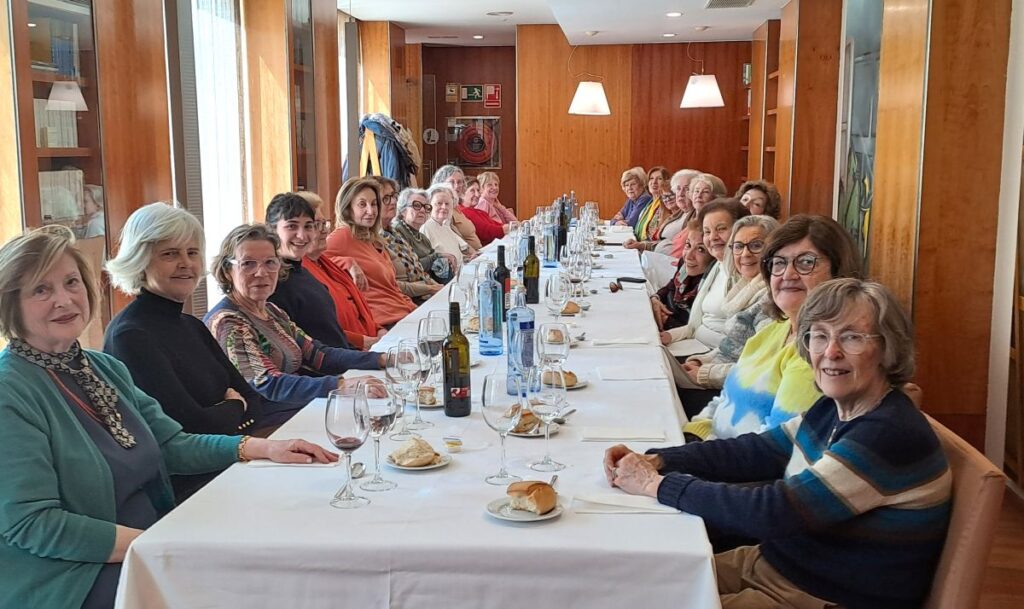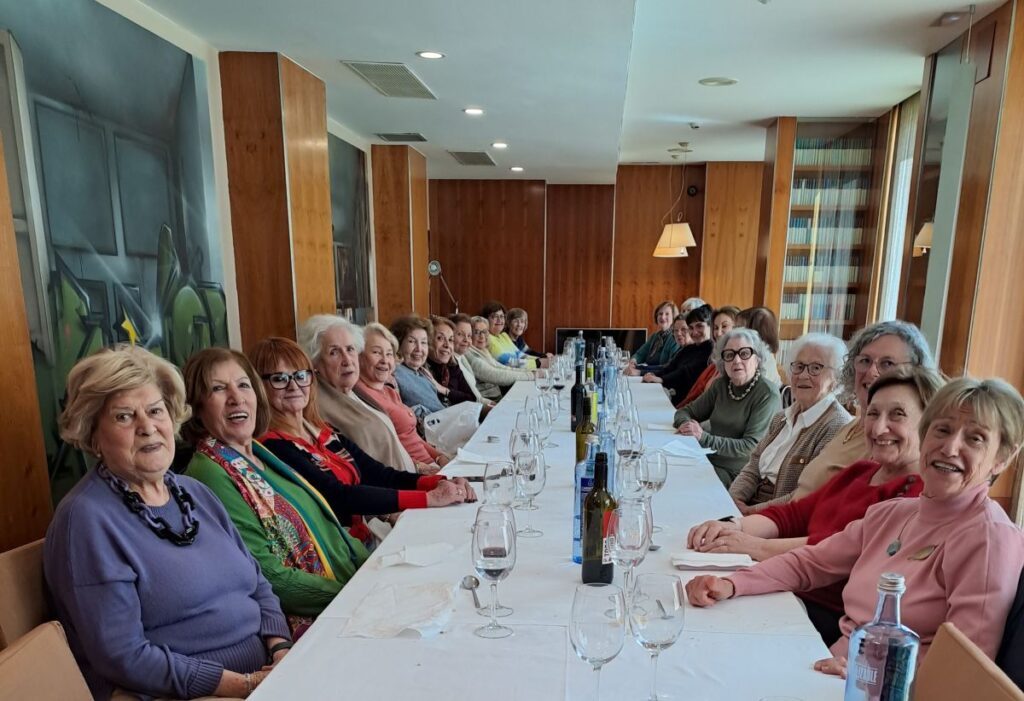After the visit to the Citadel, we set off for Zamora, a beautiful Spanish walled city, the ‘capital of the Romanesque’ with twenty-three Romanesque churches, which stands on the banks of the River Douro and has a rich historical, cultural and gastronomic heritage.
We started the next day with a visit to the Cathedral Museum and the Cathedral of El Salvador.
Cathedral Museum
The Cathedral Museum presents sculptures, paintings, liturgical objects, furniture, musical instruments and a limited sample of archaeology, along with an exceptional collection of tapestries with historical, biblical and allegorical themes from the 15th and 16th centuries, executed in the factories of Arras, Tournai and Brussels, famous for their large dimensions, artistic quality and technique.
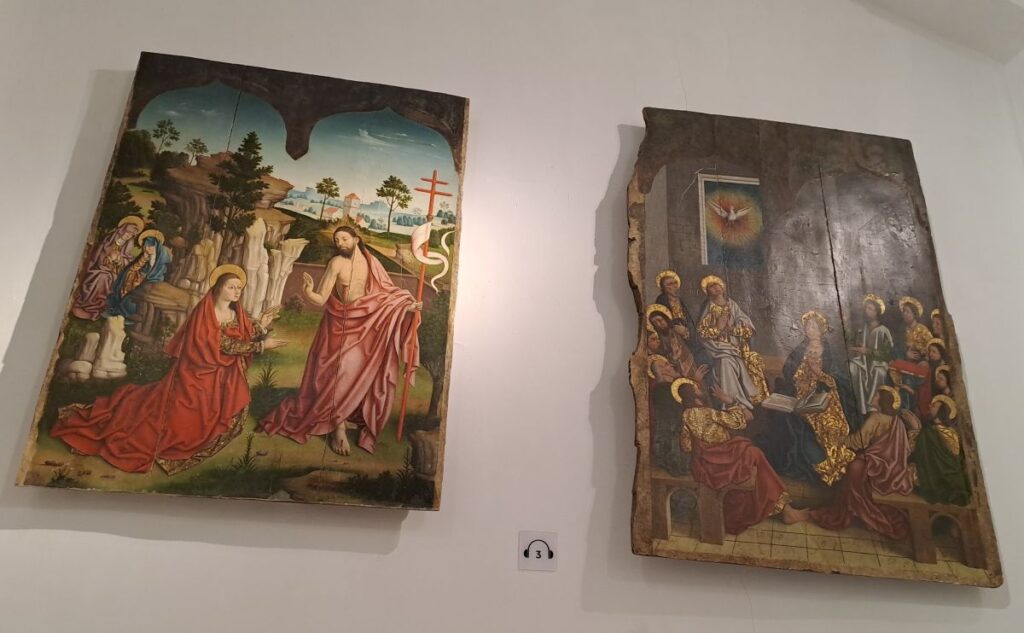
Noli me tangere and Pentecost – these are two panels from a late 15th century Hispano-Flemish Gothic altarpiece with around thirty-five panels painted by Fernando Gallego.
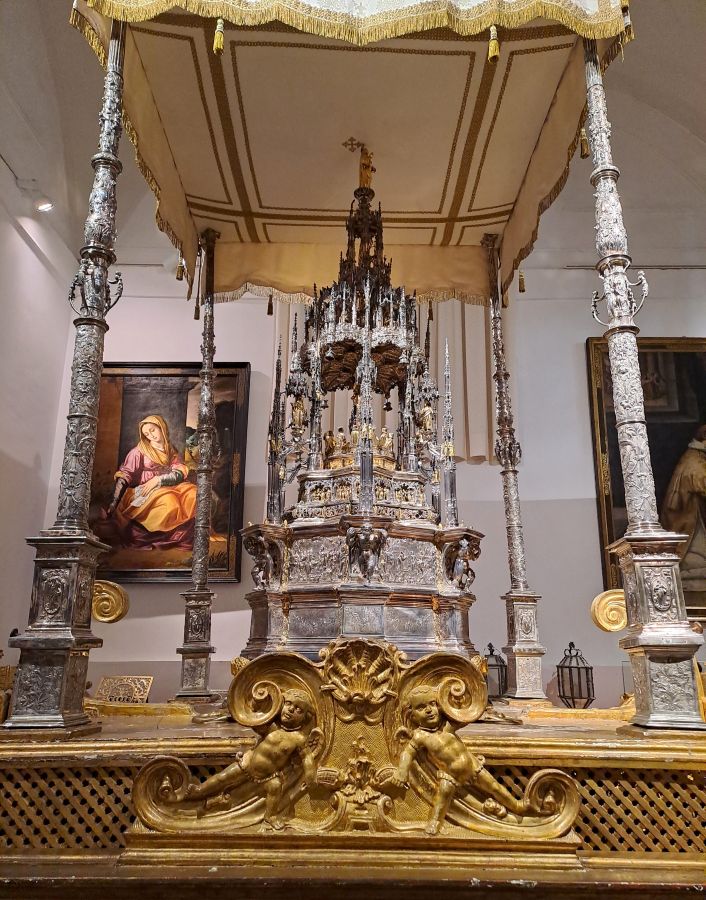
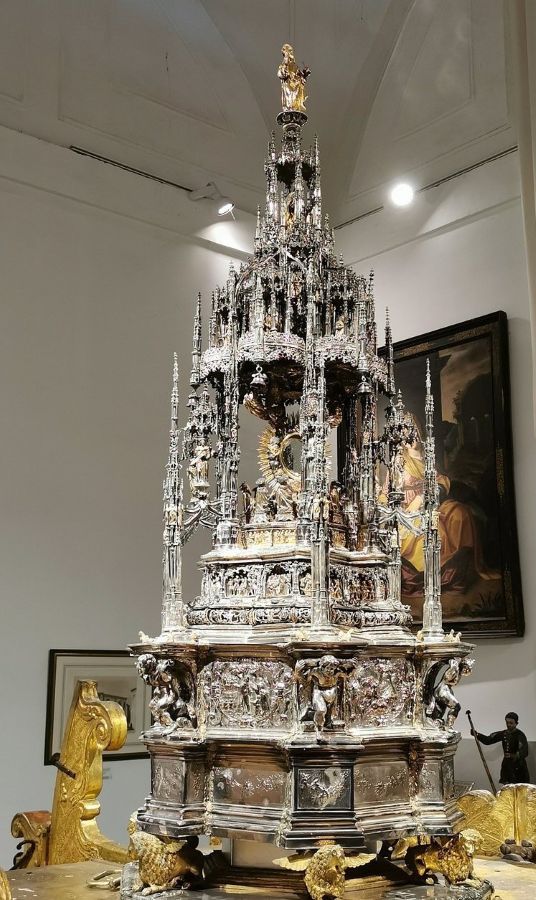
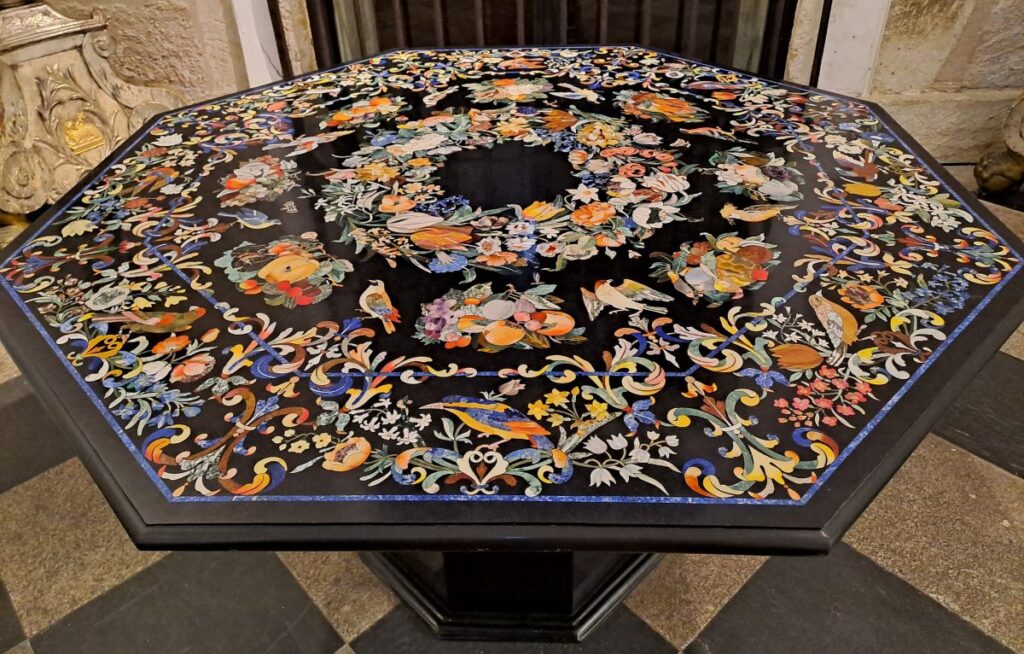


Museum’s tapestry collection
These two tapestries make up the Parable of the Vineyard Labourers series and are based on a passage from the Gospel of St Matthew. They were probably made in Brussels around 1500.

‘The Call to Labour’ shows those chosen before the Messiah’s arrival to work for Redemption.

‘The Payment of the Denarius’ shows how all the workers, both those who started at the beginning of the day and those who joined at the last minute, receive the same daily wage, a denarius, symbolising that all Christians will be received in Paradise.
Tapestries from the Hannibal series
The ‘History of Hannibal’ series consists of five of the eight panels it must have included, realised in Brussels around 1570. The tapestries show large figures and animals framed by a wide border of fruit and plants and with an upper cartouche bearing an inscription in Latin referring to the event depicted.
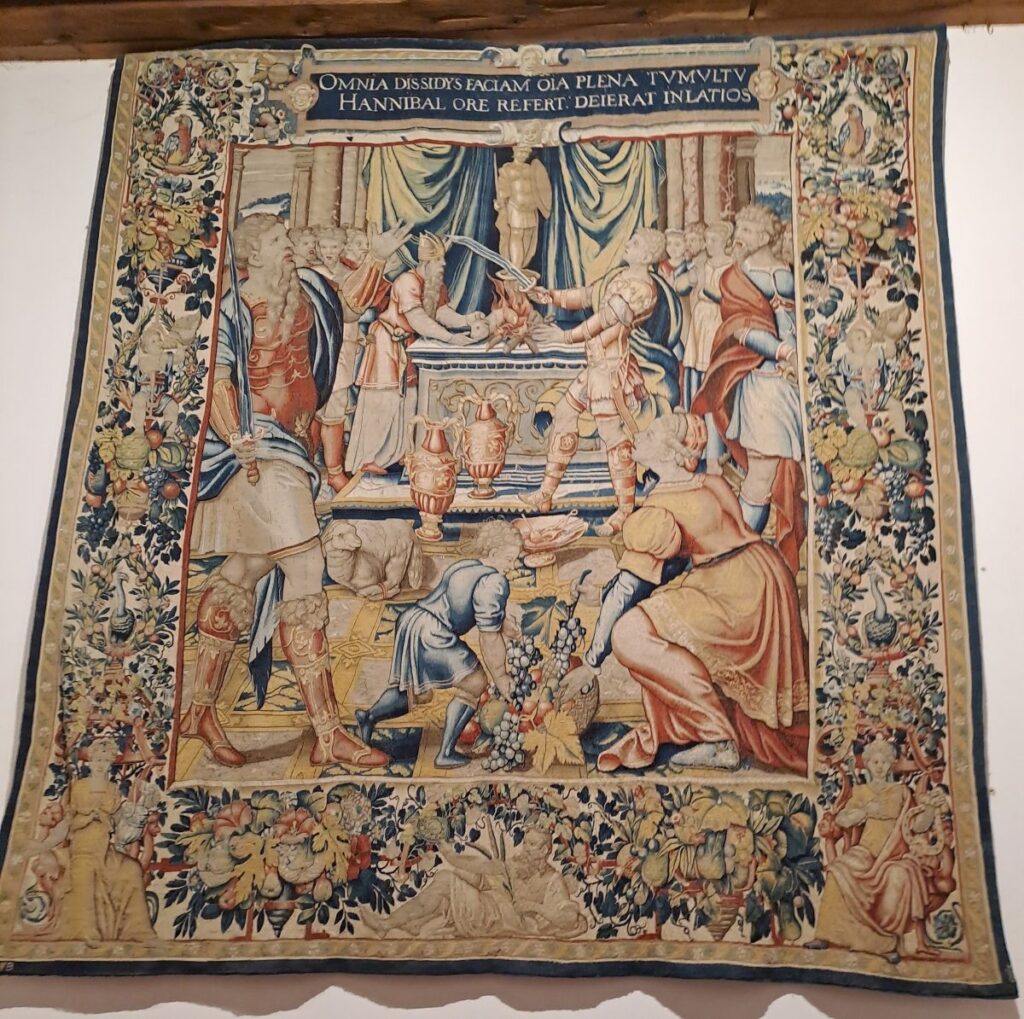
The ‘Oath of Hannibal’ depicts a scene from the story of Titus Livius, showing the sacrifice to the God of War and the warrior’s oath to fight the Romans, with his father, Amilcar Barca, as a witness.

The ‘Crossing of the Alps’ shows the Carthaginian camp with Hannibal standing and showing the baton of command to three of his captains.

‘Hannibal in Italy’ shows the Carthaginian general on horseback alongside several warriors, raising his arm in a sign of protection, while an old man offers him the keys to the city.

‘The Spoils of Cannae’ tells the story of the moment after Hannibal’s greatest victory, when the Carthaginians gather the belongings of the corpses.
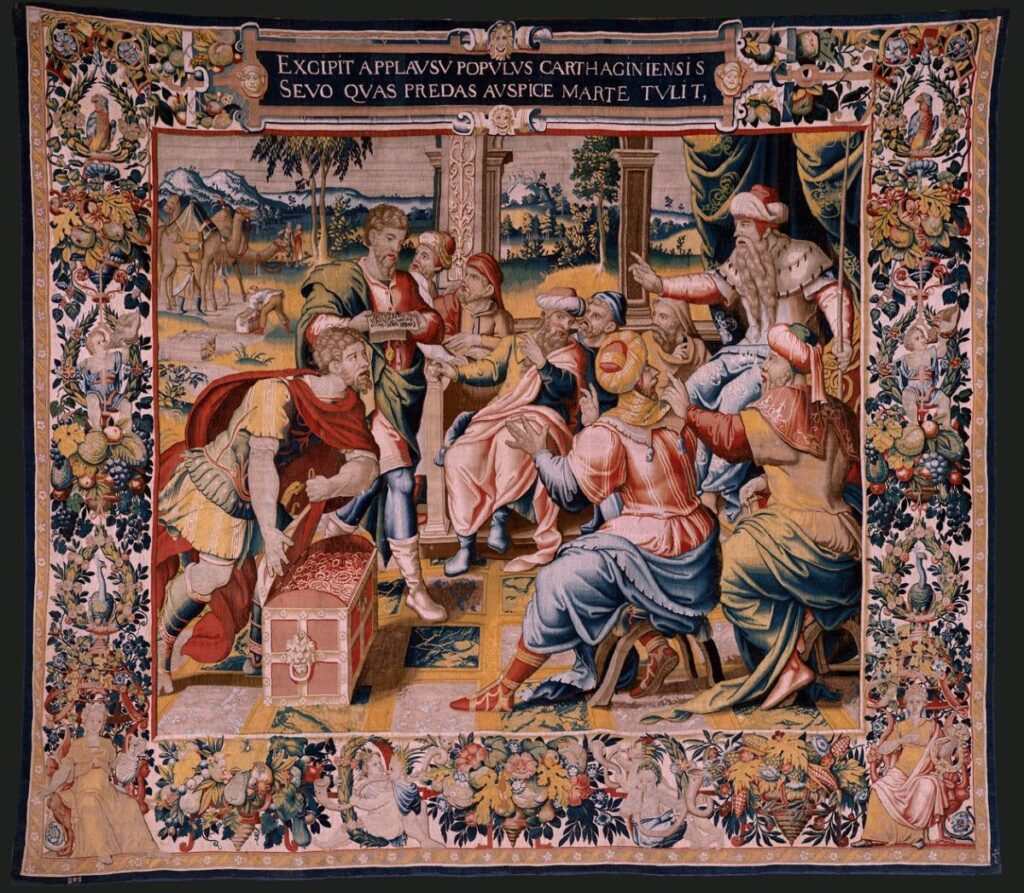
‘Magon, Hannibal’s messenger in Carthage’ tells how the Carthaginian sent his brother to report the Victory at Cannae to the Carthaginian Senate, represented by nine figures raising their hands in joy, while Magon shows a chest containing the loot.
Tapestries from the Troy series
The complete ‘Trojan War’ series of twelve panels depicted the beginning of the war up to the destruction of Troy. The tapestries were probably made between 1475 and 1485 in a workshop in Tournai. The four panels by Zamora were donated to the Cathedral in 1608, together with the one by Tarquinio Prisco, by Don Antonio Enríquez de Guzmán y Toledo, 6th Count of Alba and Aliste.
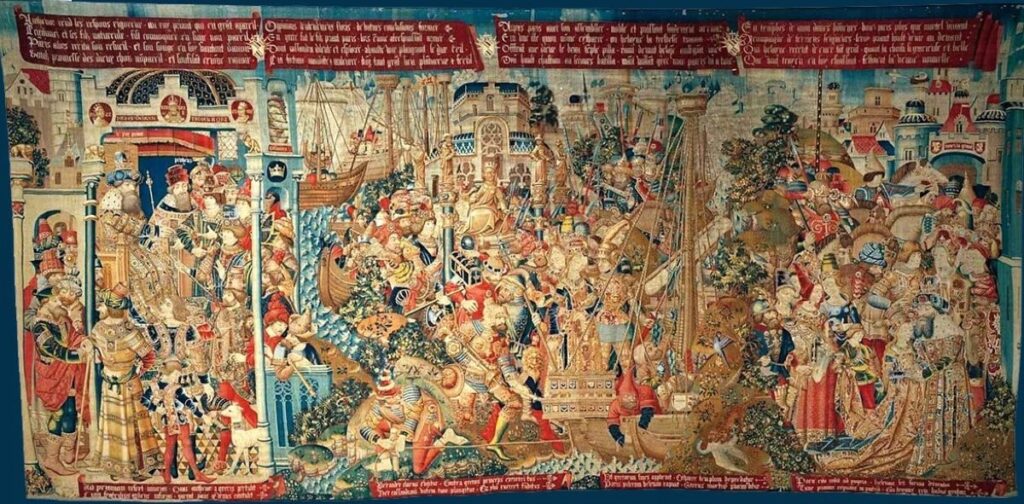
‘Abduction of Helen’ – The story unfolds from left to right, with Priam in his palace hearing from his men how the Achaeans refuse to return his sister Hesion, whom they have kidnapped; the expedition leaving Troy, arriving in Cythera and taking her out; the meeting of Paris and Helen in the temple of Aphrodite and their arrival in Troy, where Helen receives Priam’s blessing.

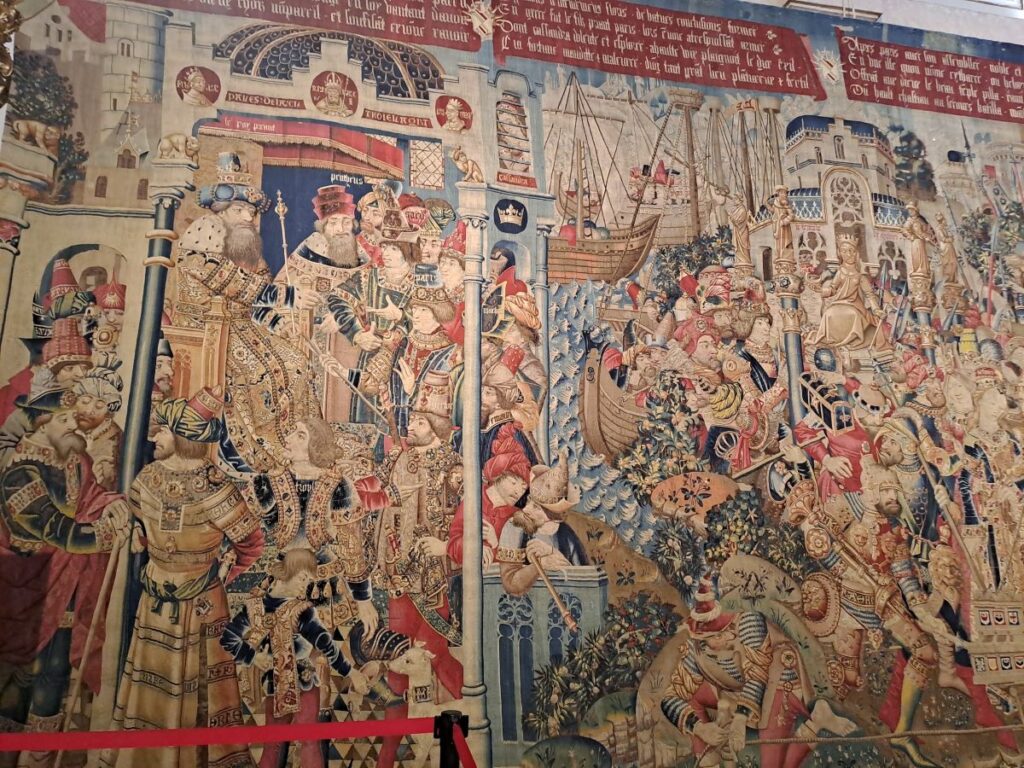
This tapestry is in the Chapter Room of the Cathedral due to its large dimensions (9.30 metres wide by 4.50 metres high).
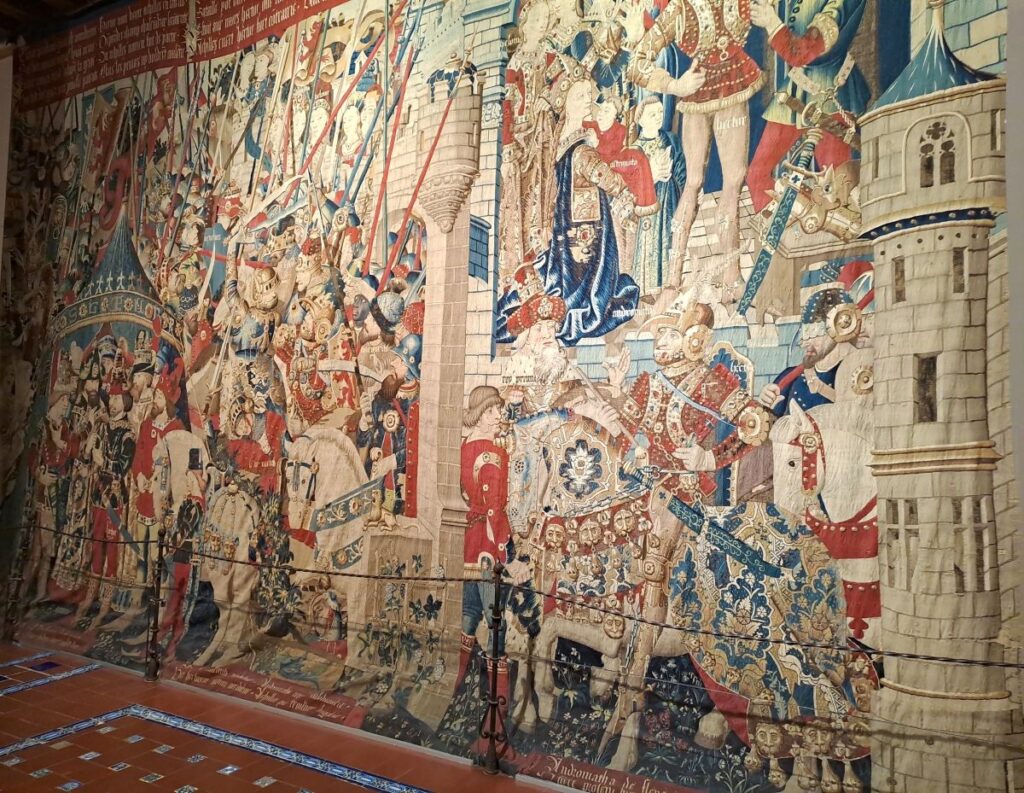
Zamora’s ‘Tent of Achilles’ is incomplete, as a quarter of the left side was lost in a fire. It tells of the interview between Hector and Achilles in the Achaean camp, the fight between the Achaeans and the Trojans while the women watch from the walls, and Hector’s preparation for the fight with Achilles.
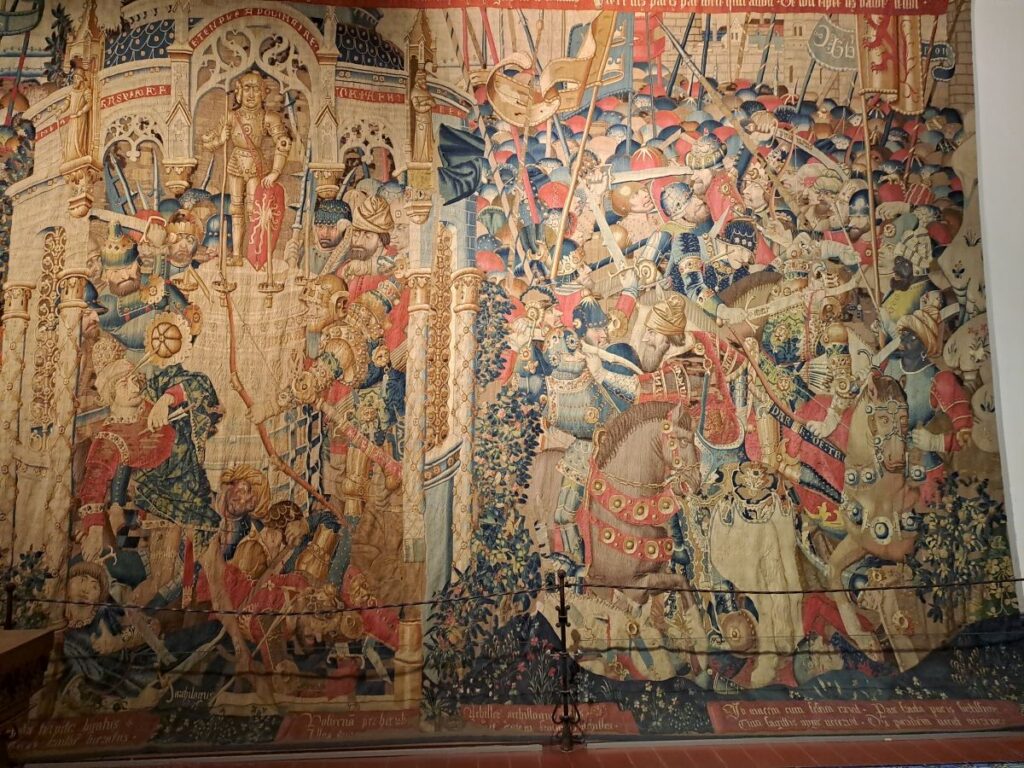
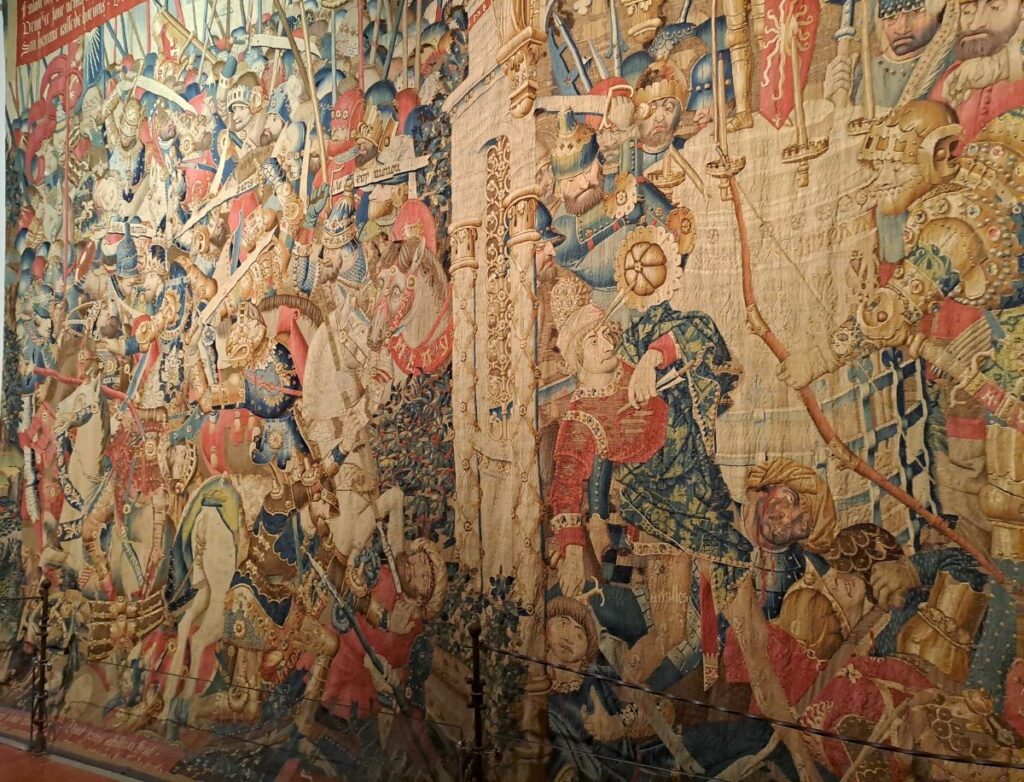
‘Death of Achilles’ – The most notable scenes include the death of Troilus, the death of Achilles at the hands of Paris and the death of Paris.
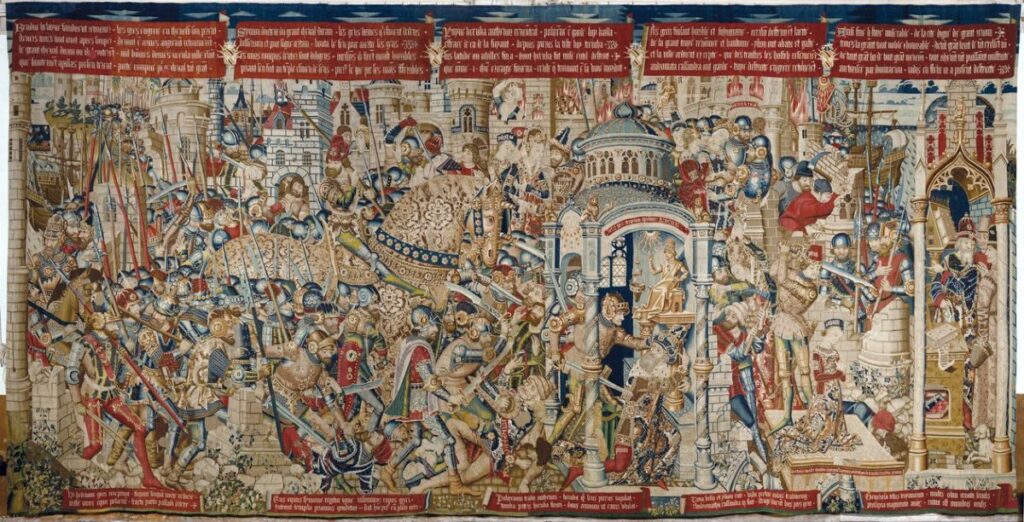
‘The Destruction of Troy’ is the last in the series and tells how the Achaeans used the horse strategy devised by Ulysses, located on the left, to enter the city; the death of Priam and the capture of Polyxena, Hecuba and Cassandra by Ajax, who is preparing to behead them. This tapestry is also in the chapter room.

‘Tarquin Prisco’ – Flemish tapestry, dating from 1475, a single panel from a series that would have centred on the History of Rome. It has three inscriptions at the top which tell of the events represented by numerous figures separated into three scenes: Lucius Tarquin advancing on horseback towards Rome, the Coronation of Tarquin and the Battle of Tarquin and the Sabines.
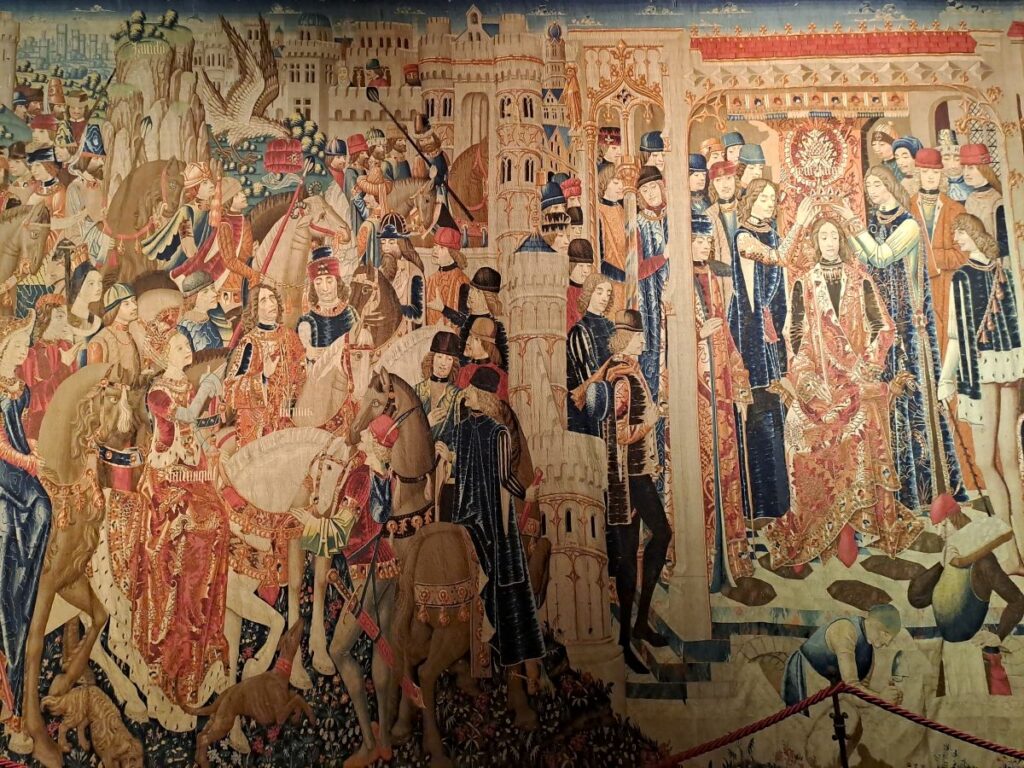

Cathedral
Situated on the highest point of the city, overlooking the Douro valley, the present-day Zamora Cathedral, in Romanesque style, began to be built at the end of the 1140s on the ruins of the previous one, commissioned by the Bishop of Zamora, Bernardo do Périgord, during the reign of Alfonso VII. The Cathedral was consecrated in 1174 so that services could begin, but the work continued.
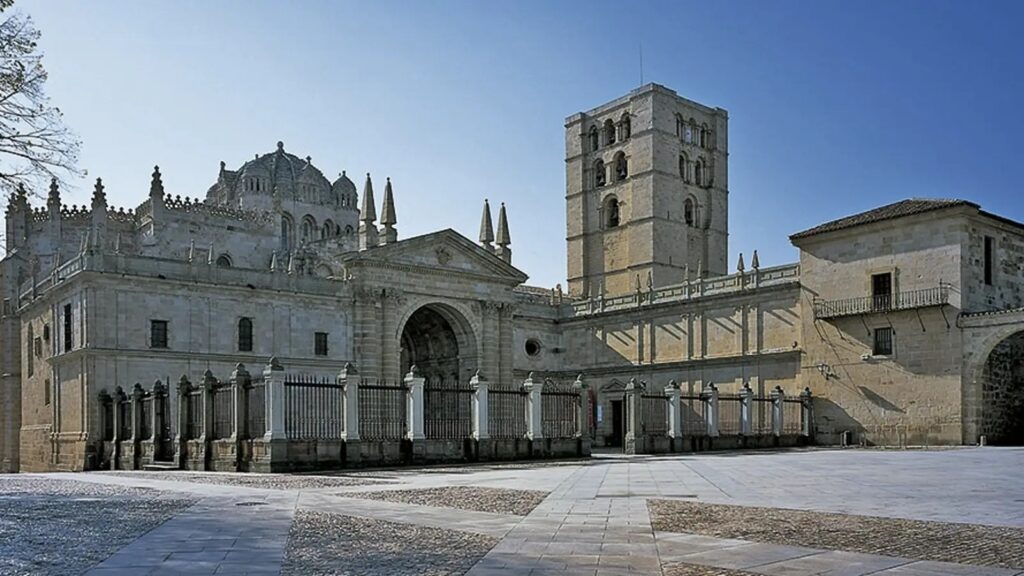
The Bishop’s Gate on the south façade is the only one of the three original Romanesque gates. It has a certain Arab influence and consists of a semi-circular extended arch with four archivolts of very closed horseshoe arches, decorated with lobes, which rest on three pairs of columns, except for the inner one, which rests on the jambs. In the tympanum of the left-hand arch are St Paul and St John, and in the right-hand arch, with plant motifs and under a canopy, the Virgin and Child, flanked by two angels.


Zamora Cathedral is characterised by its spectacular Byzantine-influenced dome, adorned with stone scales.
The 18th-century main altarpiece is a neoclassical work by Ventura Rodríguez and executed by Juan Bautista Tammi and Andrés Verda in Carrara marble, jasper and bronze. The central apse of the altarpiece is dedicated to the Transfiguration of Christ, the work of Jerónimo Prebosti. At the top of the altarpiece are white clouds surrounded by angels and the Heavenly Father.
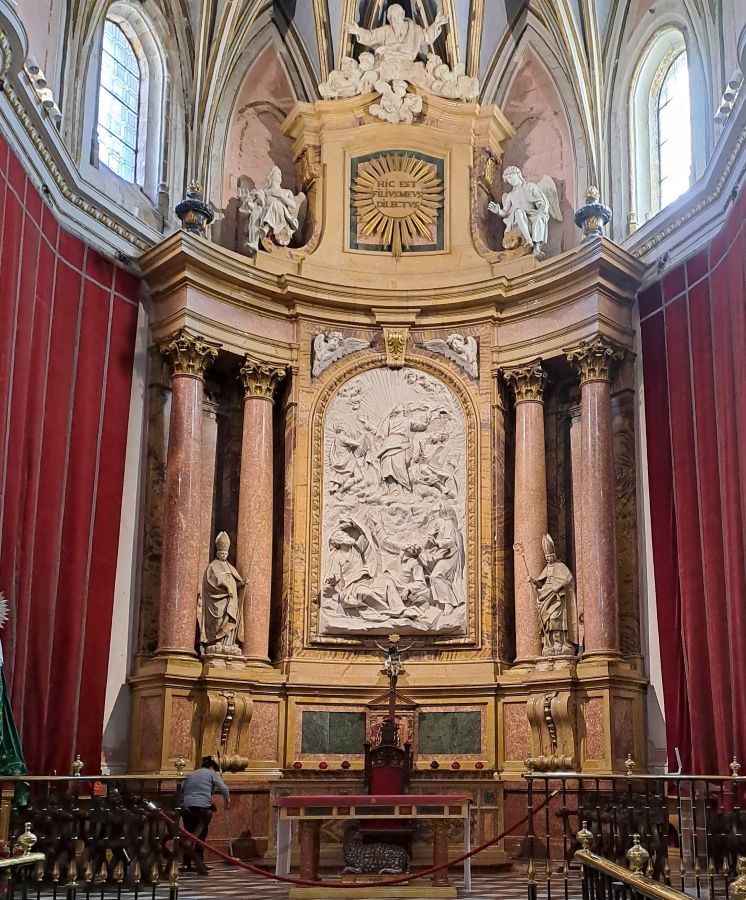
There are two other chapels next to the main chapel. In the Gospel apse, the altarpiece dedicated to the Virgin of Our Lady of Majesty, also known as the Bald Virgin, is a 14th-century Gothic carving in compact sandstone. The polychromy was done at the end of the 16th century. In the apse of the epistle, on the right, is the altarpiece of St Christ, in the Renaissance-Mannerist style, executed at the end of the 16th century.
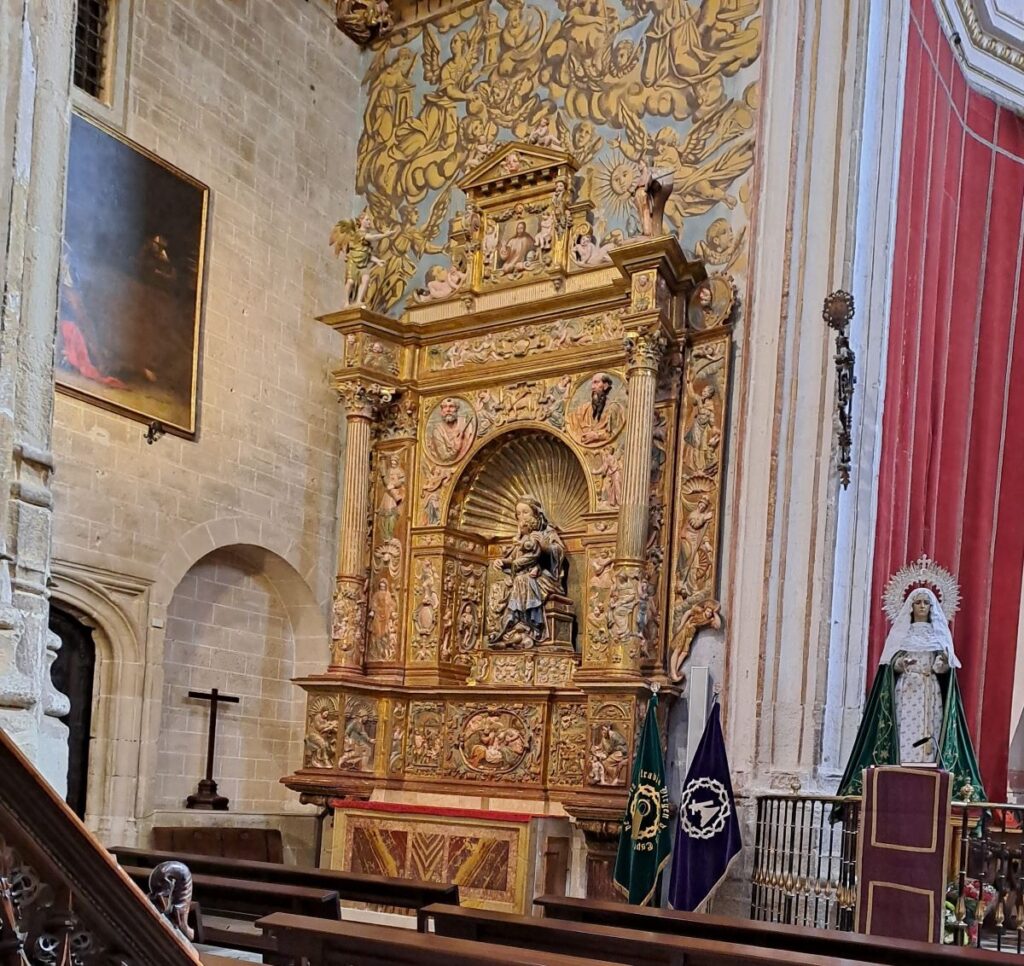
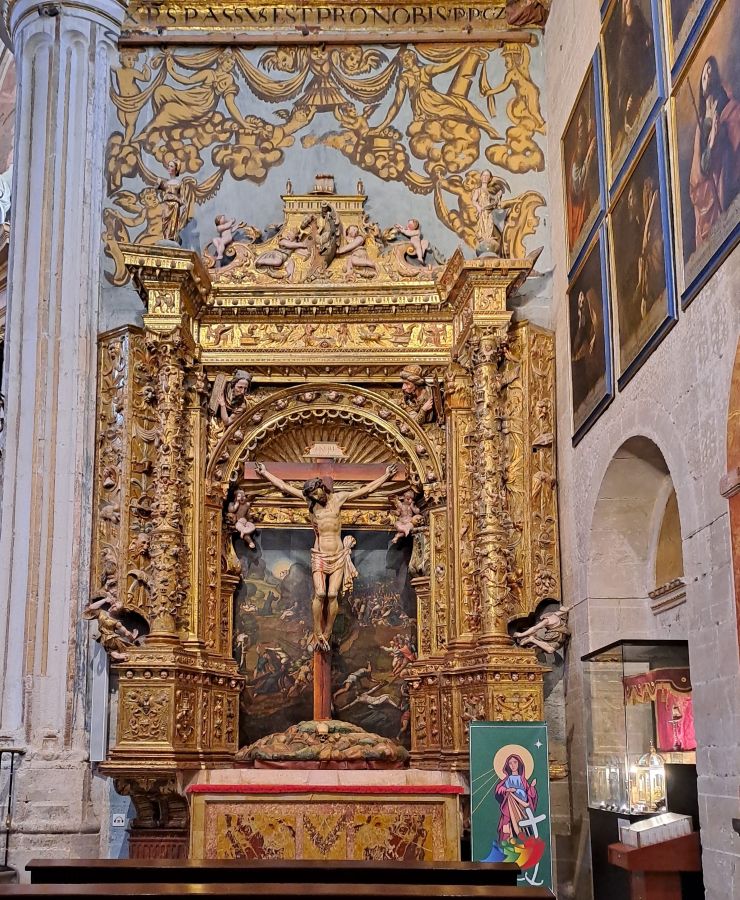
The Choir, made of walnut wood by Juan de Bruxelles between 1503 and 1507, is a magnificent work in the late Gothic style with 85 seats, arranged in a U-shape with two levels. The main seat has a beautiful pinnacle. The organ dates from the 17th century.
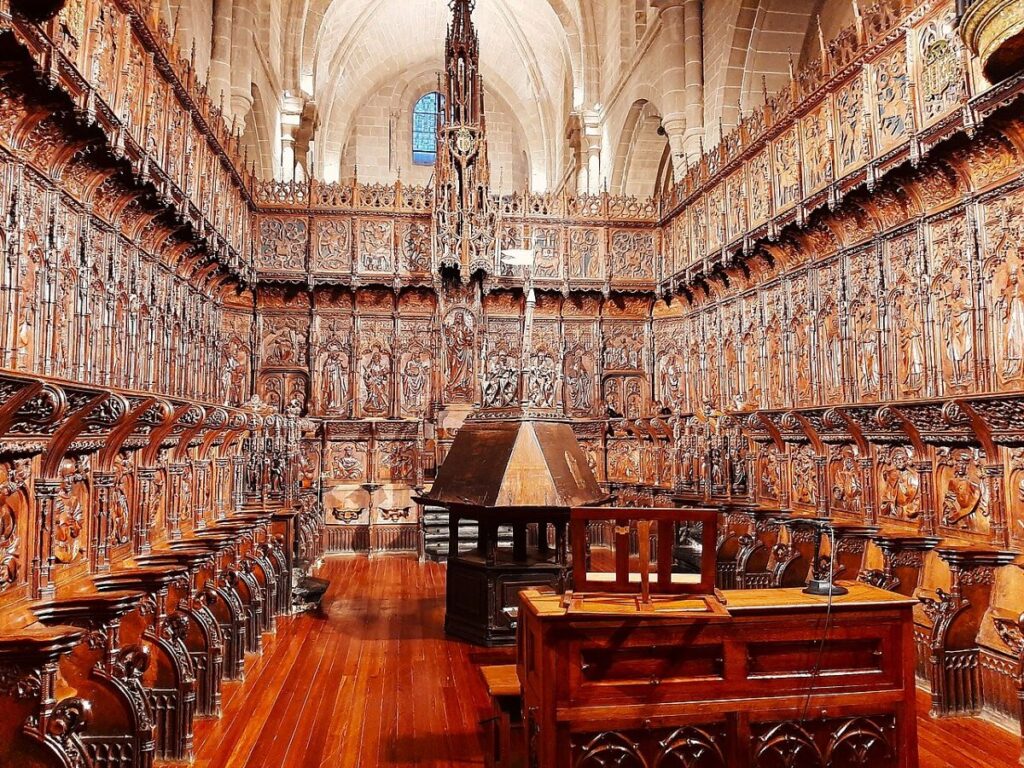
The back choir has a late Gothic composition, with two floral Gothic doors on the sides and an altar in the centre with a panel depicting Christ the Saviour of the World in his Glory, among the blessed. It is an important pictorial work from the first third of the 16th century.

Chapel of Saint Ildefonso or the Cardinal – Founded by the Zamoran cardinal Don Juan de Mella in the first half of the 15th century, it is one of the most beautiful. The railing is attributed to the workshop of Francisco Villalpando, dating from the second quarter of the 16th century (1670) and the entire chapel is decorated with wall paintings dating from around 1600 showing the life of St Ildefonso on the outside and biblical scenes on the inside.
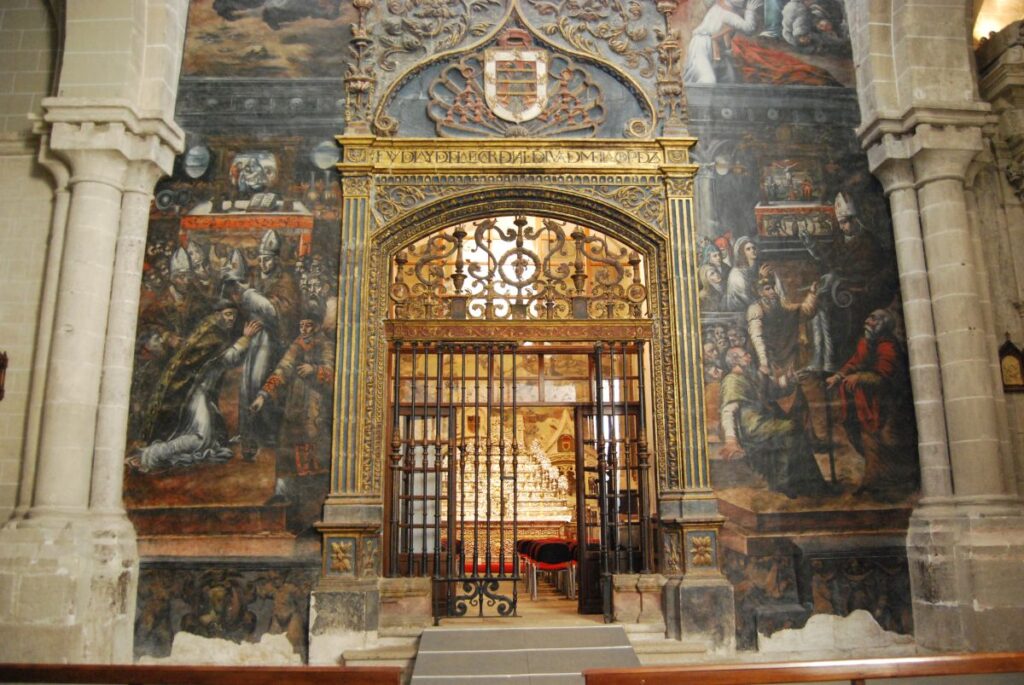
The silver altar and tabernacle were designed by Manuel Garcia Crespo in 1730 and the steps by Manuel Flores Herrera in 1763. The altarpiece depicting the life of St Ildefonso was painted by Fernando Gallego in the 1470s.

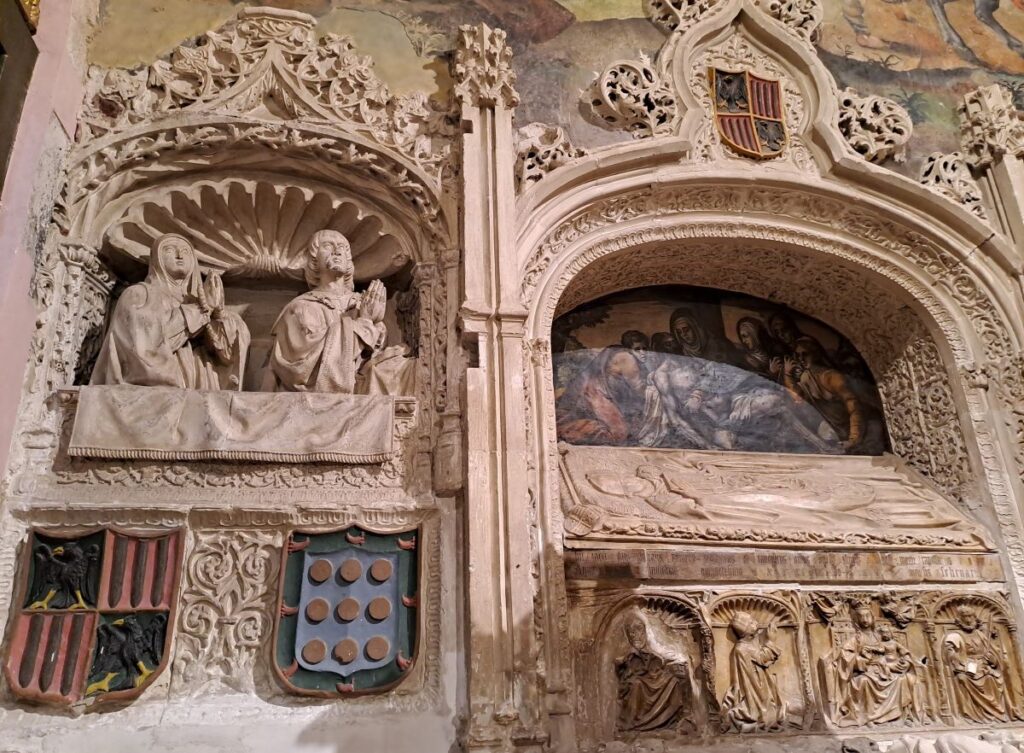
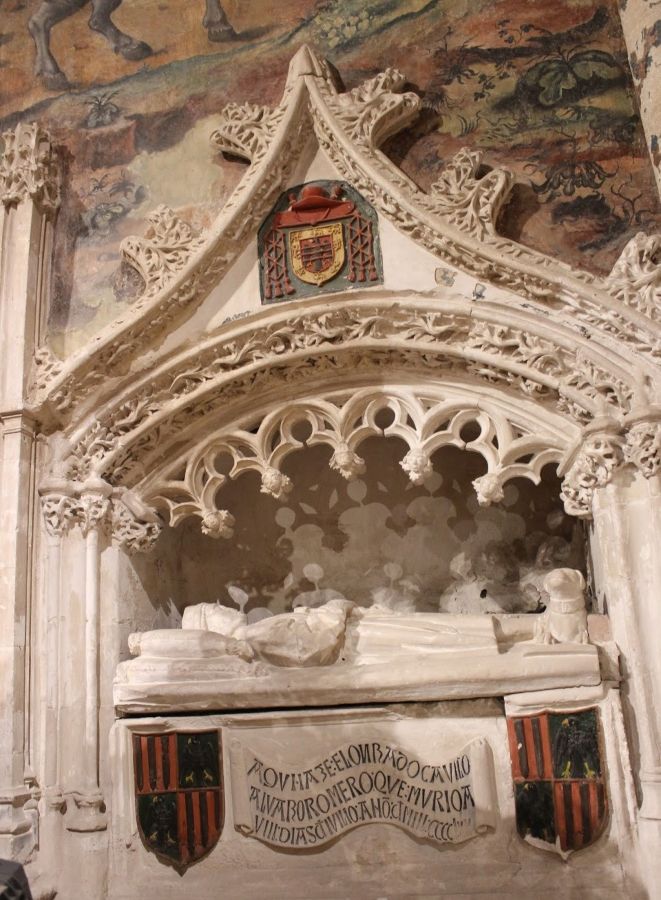

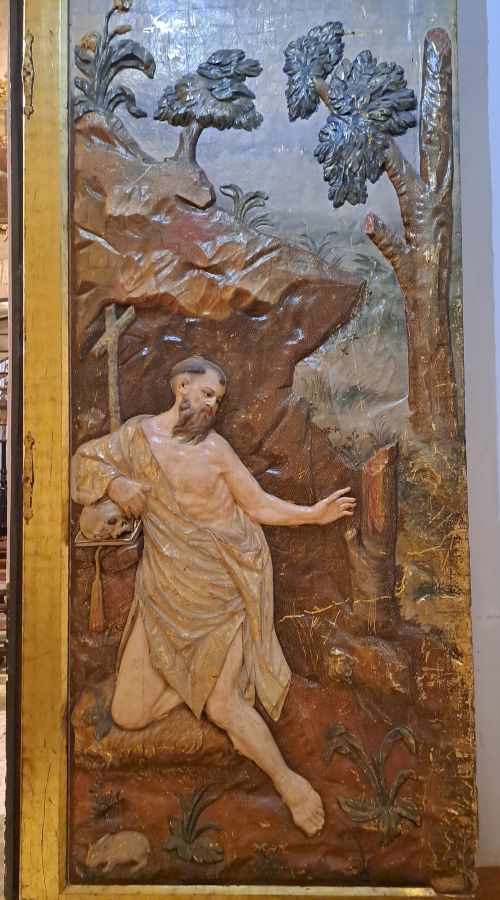
The Chapel of St John the Evangelist is at the back of the Epistle nave, with a Renaissance altarpiece dedicated to St John the Evangelist, represented by the eagle and the book of the Gospels. St Mary Magdalene, lying in the field with the perfume bud and the cross in her left hand, completes the lower part of the altarpiece. A 15th century baptismal font was also recently installed in the chapel.
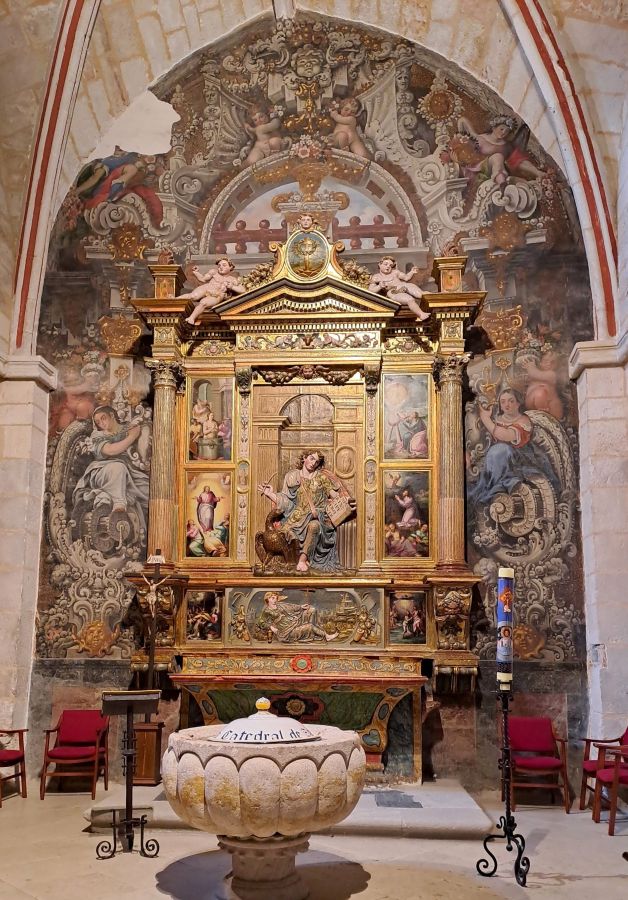
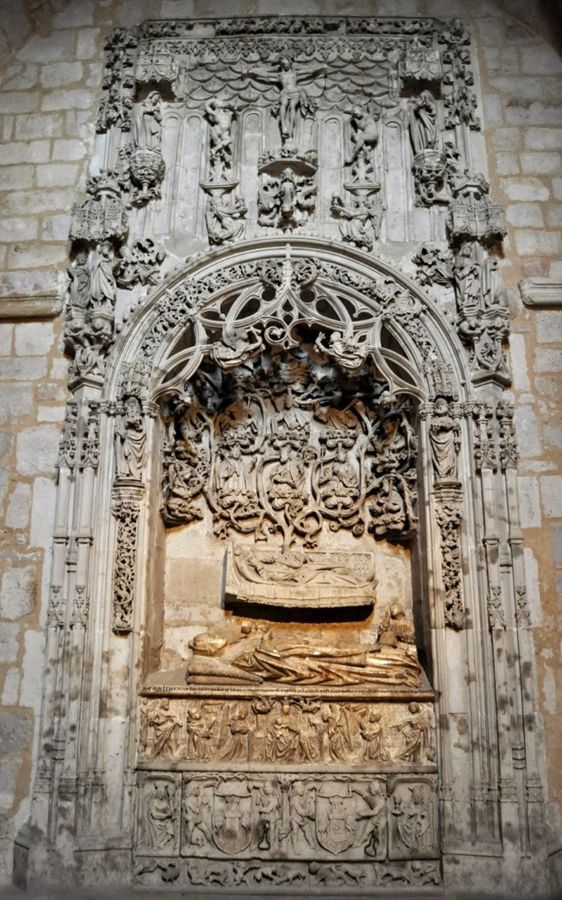
The funerary monument of Don Juan de Grado (above, right), who died in 1507 and was a canon of the cathedral, dates from the early 16th century and is located in the chapel on the right. Made of alabaster and sandstone, it is one of the best examples of late Gothic in Spain.
The chapel of Santa Inês, built in the mid-17th century, is located in the lower body of the bell tower, in an area known as ‘the dungeon’ because it was used as a prison for the Cabido. The chapel also houses a sculpture of Christ lying down by Luis Álvarez Duarte from 2001.
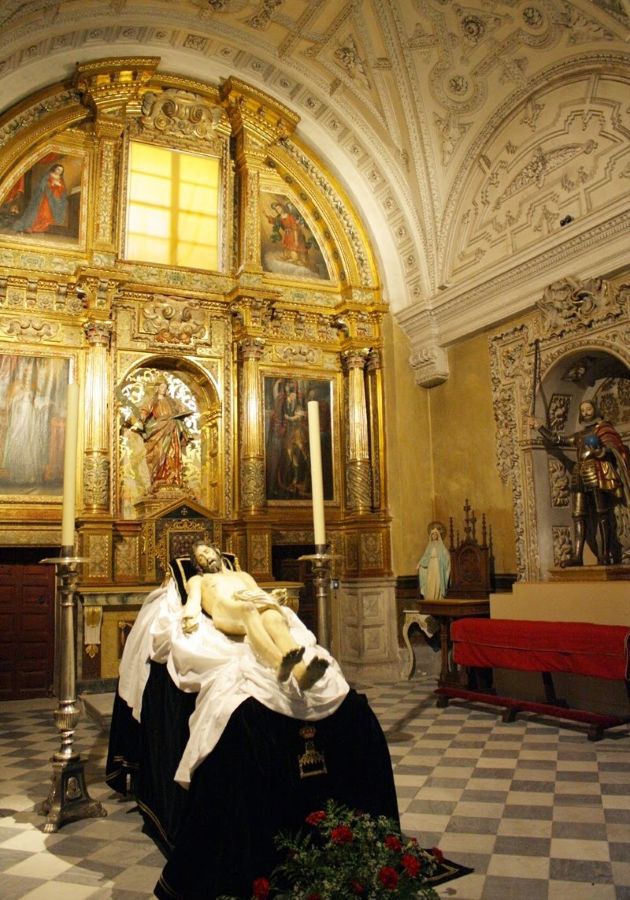
St Paul’s Chapel, with a plateresque portal and a polychrome baroque altarpiece of the Conversion of St Paul, sculpted by Cristóbal de Honorato el Velho in 1632.

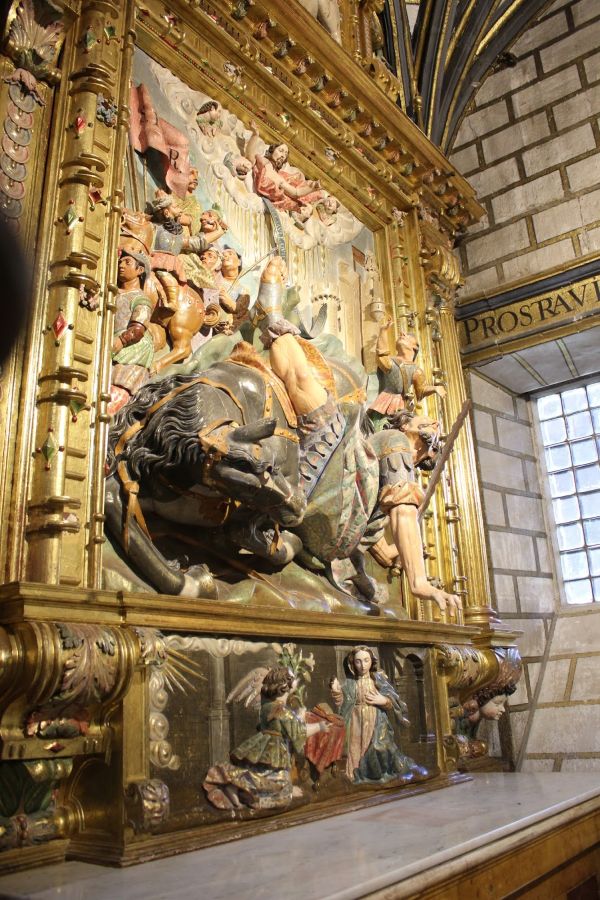
The Chapel of San Miguel or the Most Holy, also called ‘San Miguel de los Caballeros’. It has a late 16th century Renaissance altarpiece dedicated to Our Lady of Mercy, sculpted by Juan de Montejo and polychromed by Juan Ruiz de la Talaya, and the 16th century tombs of Balbás, canons of the cathedral.
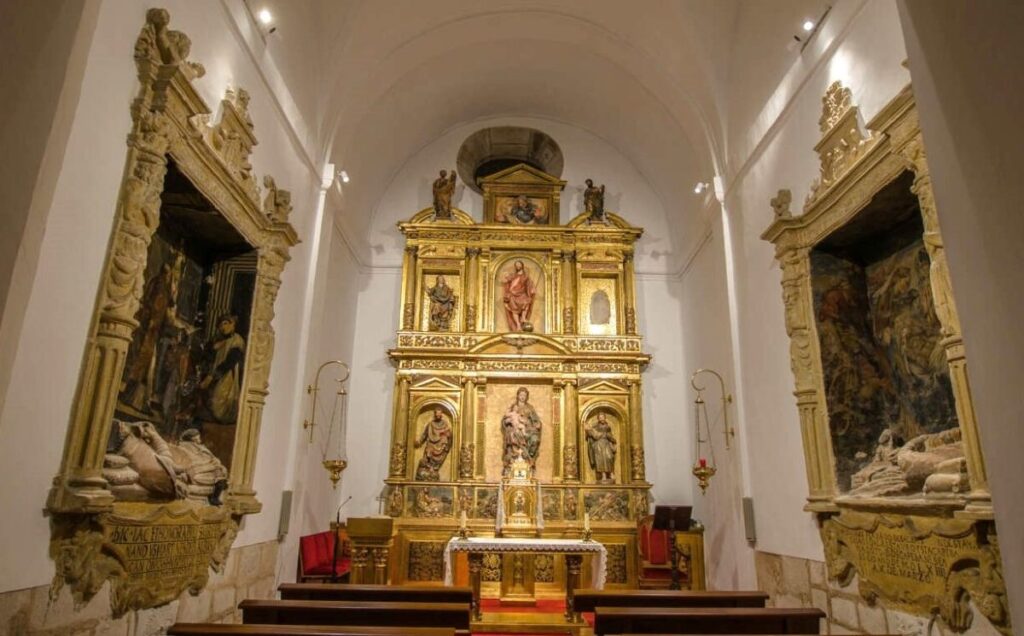
Chapel of St Bernard, on the Epistle side, presided over by a beautiful carving by Arnao Palla, a Flemish sculptor, of the venerated Christ of the Insults or Christ of the Wounds, from the 16th century. In the chapel we can also see this 1755 altarpiece of St Bernard’s Miracle of Lactation.
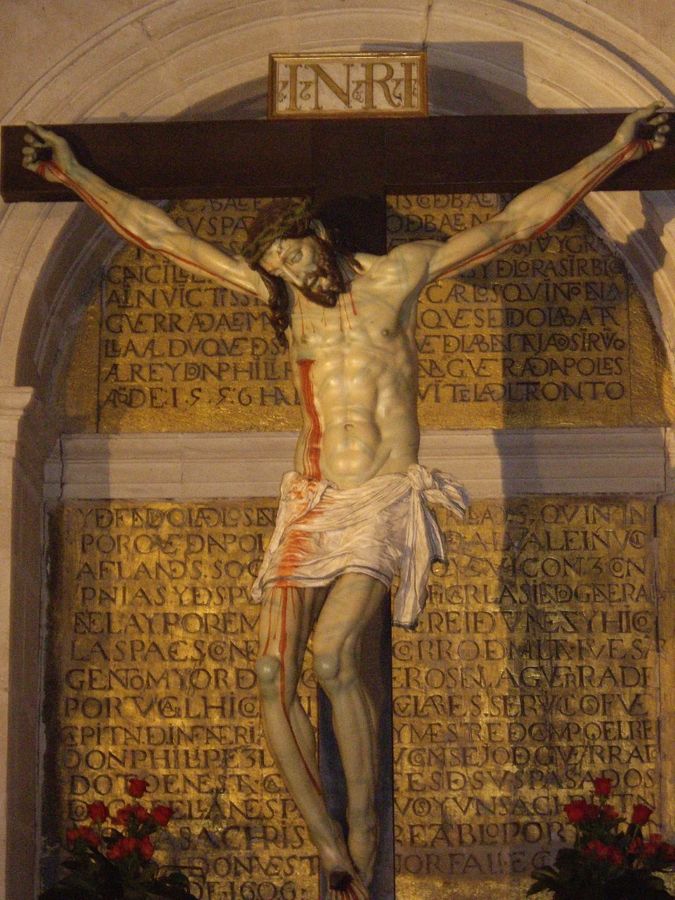
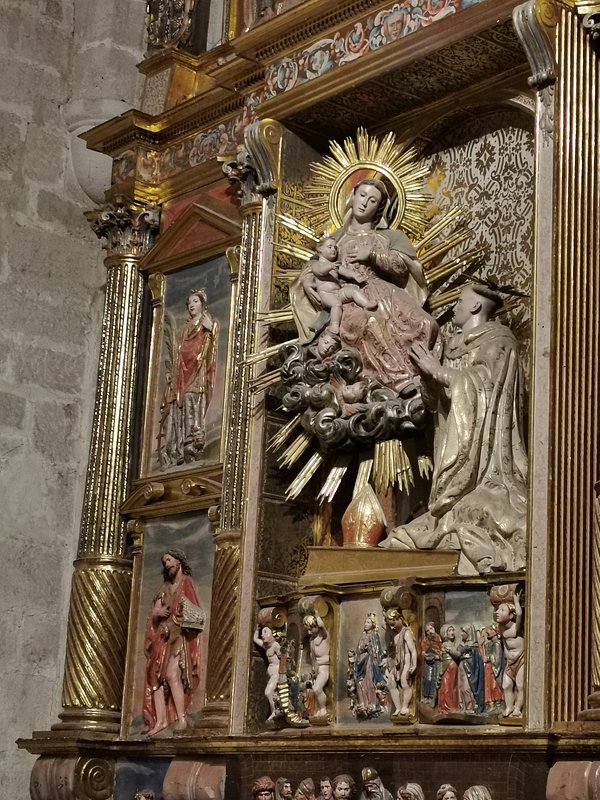
On the wall of the Nave of the Epistle, the recently discovered and restored Archosolium of Don Lope Rodríguez de Olivares. The tympanum shows the Transfiguration, a polychrome stone work from the first third of the 14th century.

Plateresque portal, with walnut doors from the same period as the choir stalls, decorated with figures, plant and animal images, through which the Cathedral is accessed and exited.

Historical centre
Once the visit to the Cathedral was over, there was a walk through the historic centre, past the church of São Pedro and Santo Ildefonso, the church of Saint Mary Magdalene and the Convent of Corpos Christi.

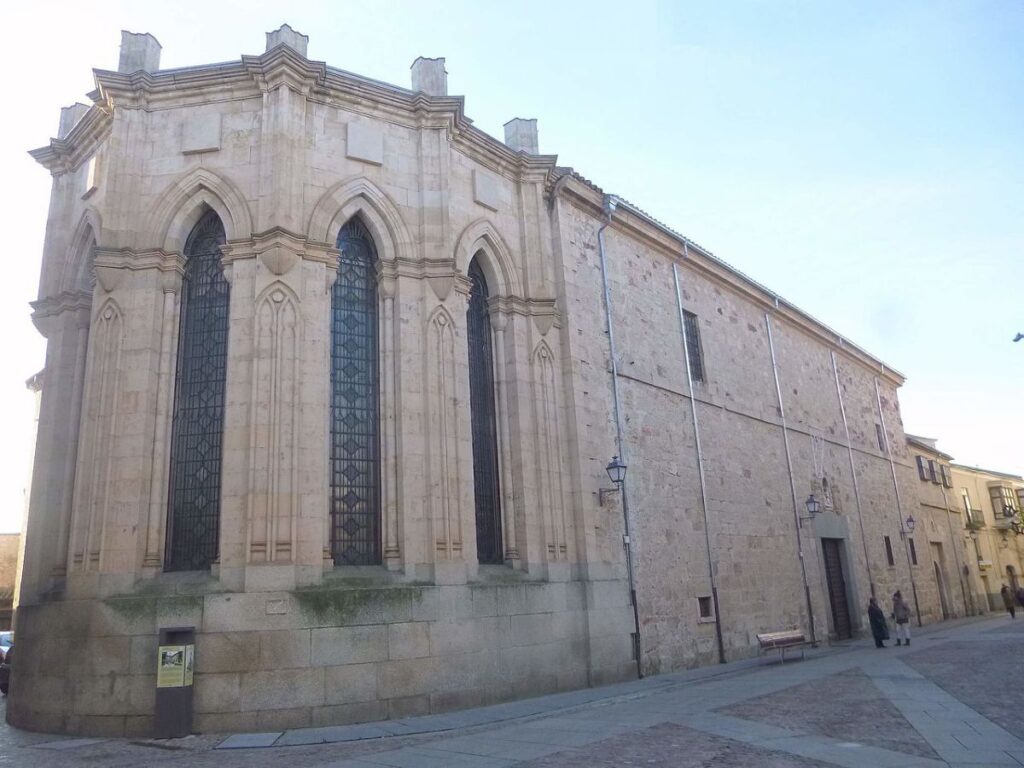
The Church of St Mary Magdalene (photos below) is a 12th century Romanesque church. On the south portal, the archivolts are decorated with plant motifs representing heavenly paradise, resting on four pairs of columns whose capitals depict fantastic animals.


Inside, there are two tabernacles built into the front corners of the nave and covered with a barrel vault. The most noteworthy is the Romanesque tomb of an unknown lady, attributed to Queen Urraca of Portugal, first wife of Ferdinand II, in which some angels appear carrying her soul to paradise.

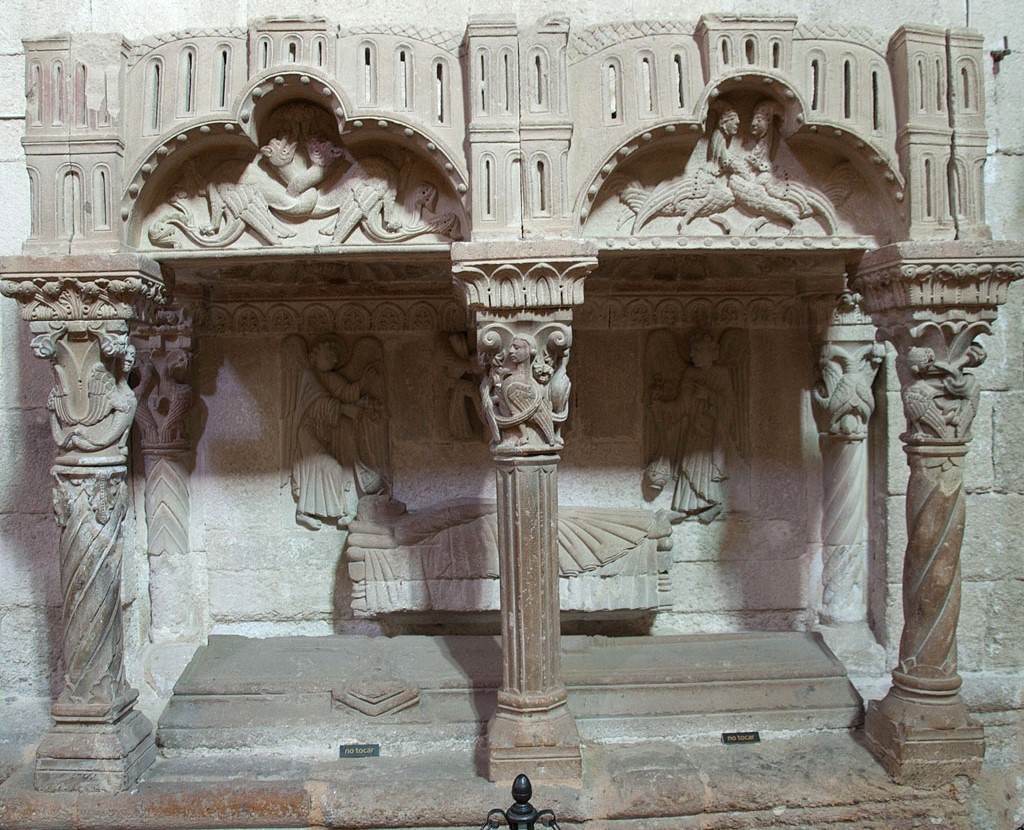
This was followed by the Ramos Carrión Theatre, inaugurated in 1916, and the Plaza Viriato, which owes its name to the statue at its centre, from the end of 1903, designed by Eduardo Barrón. In the square, in addition to the 17th century Provincial Deputation building, which we also visited, is the Palace of the Counts of Alba and Aliste, an example of Spanish Renaissance architecture from the early 16th century, which is now the Parador of Zamora.
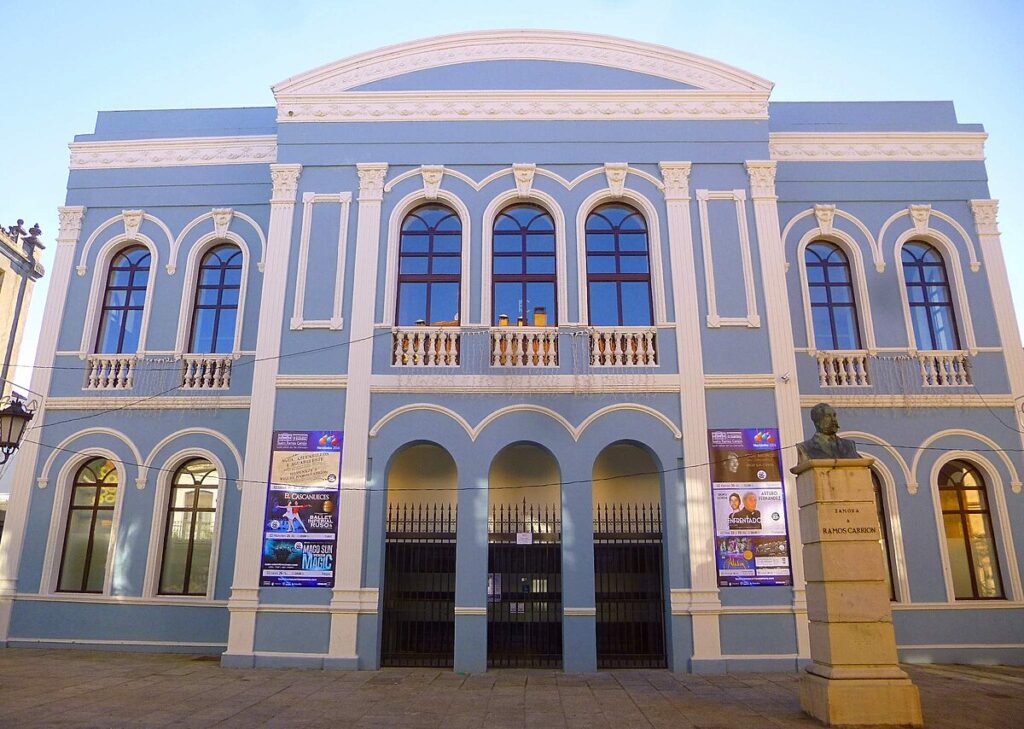
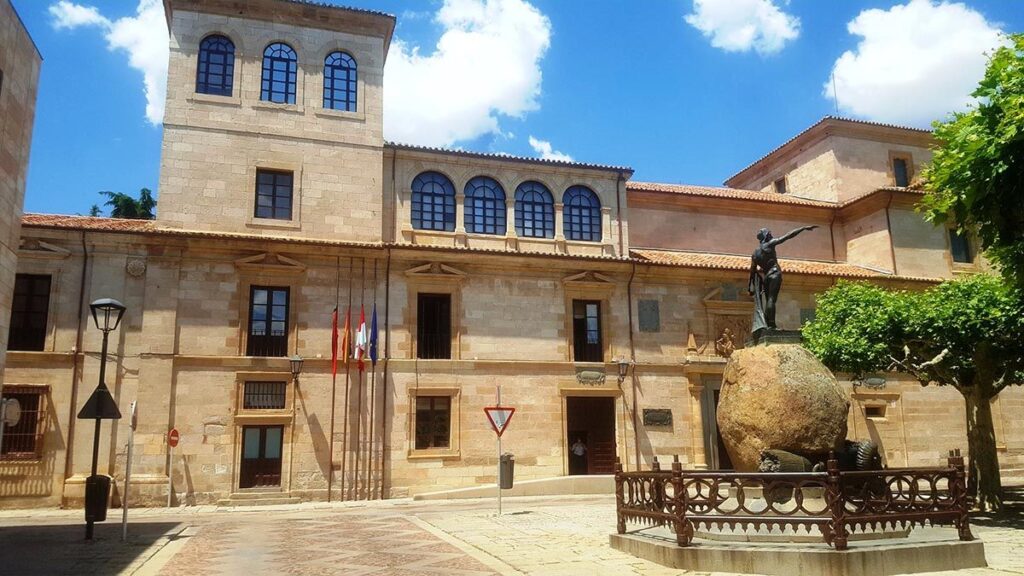
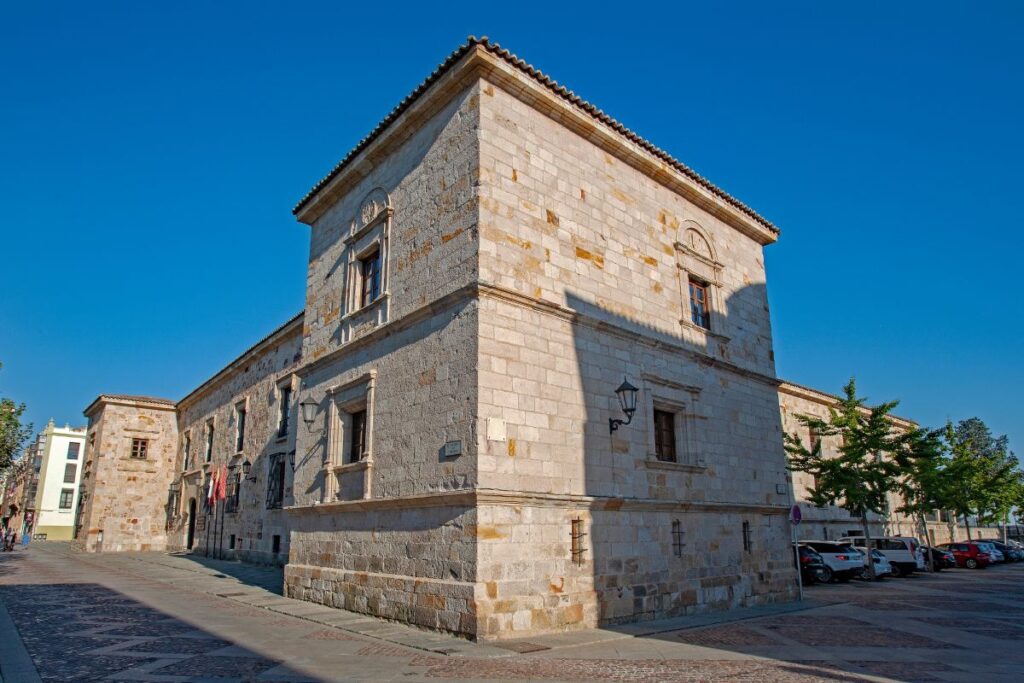
This brought us to the Plaza Mayor, where you’ll find the Romanesque Church of St John the Baptist, the sculpture El Merlú (which represents a pair of friars, armed with a drum and horn, calling the confreres of the Confraternity of Jesus Nazarene), the old Town Hall (dating from the 15th century) and the current Town Hall.

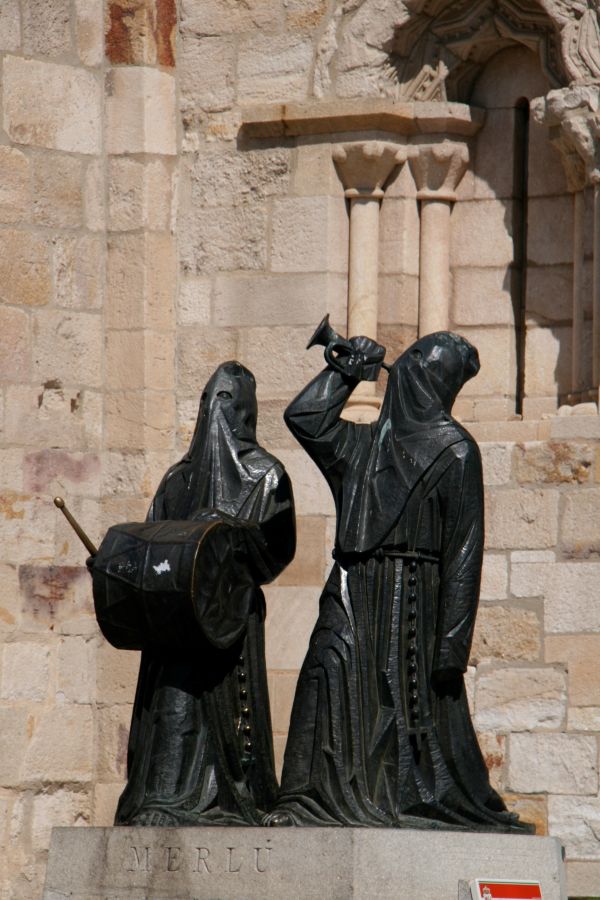

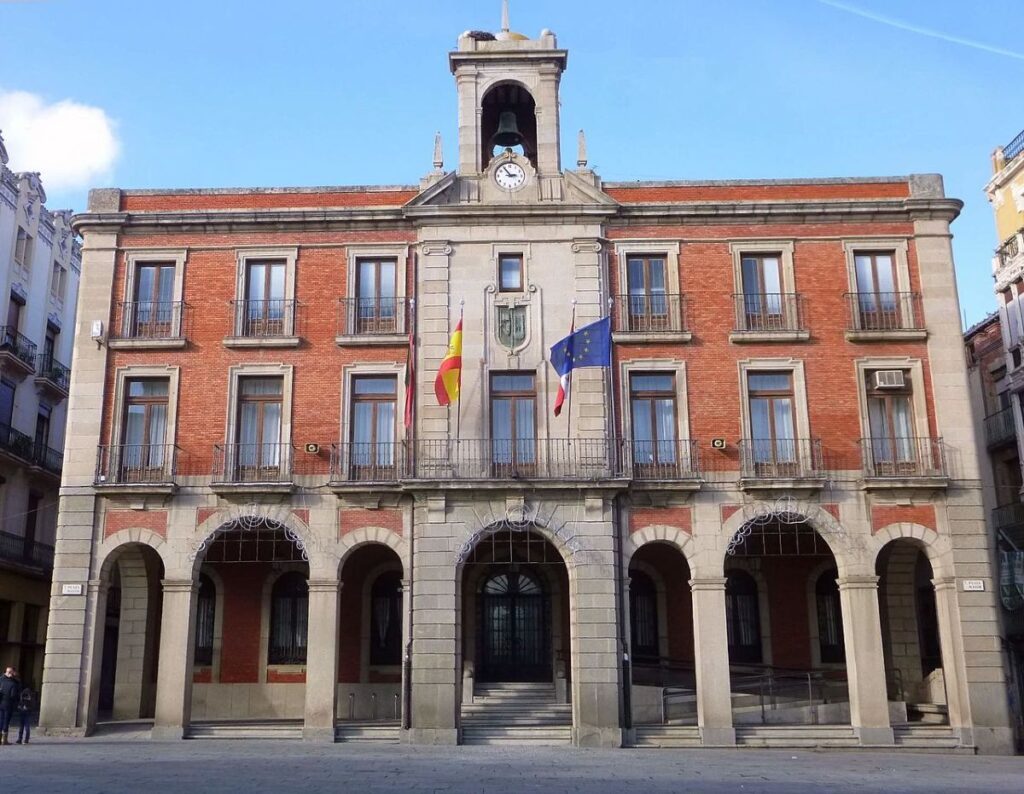
Return to the hotel for lunch, after which we set off for Salamanca.
